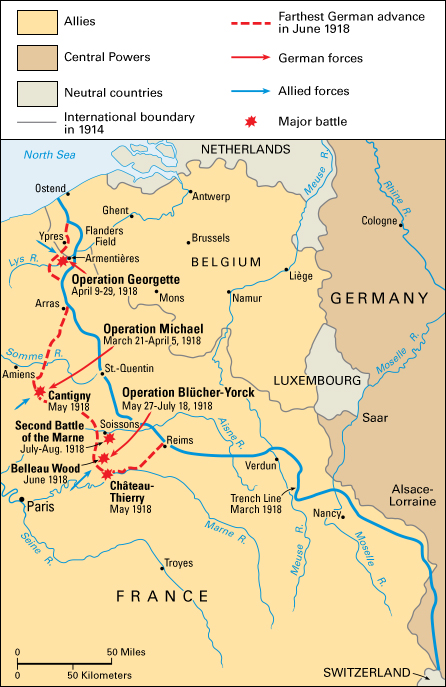On March 21, 1918, 100 years ago today, the German army launched a massive spring offensive against Allied troops during World War I (1914-1918). The German Spring Offensive was actually a series of assaults on Allied positions from March 21 through July 18, 1918, along the Western Front, the battlefront that stretched through Belgium and northern France. The German assaults broke the Allied lines and ended the stalemate of trench warfare (fighting from fortified ditches). The offensive gained much territory, but it failed to achieve German victory. It also exhausted the German army, setting the stage for Allied counterattacks and an ultimate Allied victory in World War I.
For most of World War I, the strength of the German military was split. Fighting against the British and French (and later, the American Expeditionary Forces as well) on the Western Front required millions of German troops. At the same time, German forces were needed to battle Russian, and later Romanian, forces on the Eastern Front. The Eastern Front would eventually stretch from Estonia to Romania.
By December 1917, both Russia and Romania were defeated and nearing surrender. The end of fighting on the Eastern Front then allowed Germany to concentrate its military on the West. For the first time, German forces would outnumber the Allies on the Western Front.

The Germans needed to take advantage of their numbers in early 1918. By that time, the United States had entered the war on the Allied side, but the majority of U.S. forces had not yet reached Europe. The Germans planned a huge offensive that sought to force an Allied surrender before U.S. troops could arrive in strength.
Beginning on March 21, German assaults took place along the Somme and Aisne rivers in northern France, and in Flanders, on France’s border with Belgium. The Germans hoped to destroy the British army and force France to negotiate a peace. The German assaults gained much ground, and some German troops reached the Marne River northeast of Paris, the French capital. However, heavy casualties (people killed, wounded, captured, or missing), failing supplies, and Allied counterattacks ground the last of the assaults to a halt in July.
The offensive took a heavy toll on the German army, with more than 500,000 casualties. Having used up its reserves from the Eastern Front, Germany could no longer replace such huge numbers of troops. The casualties and lack of overall success badly damaged German morale. Allied casualties also reached 500,000. However, by the offensive’s end, more than 1 million U.S. troops were in France and continuing to pour into the country at a rate of more than 250,000 each month. Massive Allied assaults began in August 1918 and continued until Germany signed an armistice (agreement to stop fighting) in November. The agreement ended World War I.
Untitled Document
Can't view the linked articles? Subscribe to World Book Online

World Book Online delivers a progressive sequence of core databases supported by supplemental
tools, such as language translation, graphic organizers, and unique Webquests. Moving from
Early World of Learning to World Book Advanced, World Book Online aligns end-users with their
appropriate learning levels. Each stand-alone site provides additional features to support the
needs of users’ specific capabilities.
The World Book Difference
World Book combines cutting-edge technology with traditional editorial excellence to produce
authoritative, trustworthy, and unbiased content. The digital content is updated in real time and
carefully curated for each learning level. Accessible 24/7, the content is available on a variety of devices.
World Book Online combines 21st-century instructional techniques with timely information.
By breaking down complex topics and using easily understandable text, World Book Online helps to
build fluency and increase comprehension. Featuring single sign-on capability, these sites are paired
with highly visual content to engage even the most reluctant reader. Our collection of resources kindles
a lifelong learning experience for every user. This adherence to clarity, currency, and accuracy makes
World Book’s digital offerings an information hub for the classroom, library, and beyond.
Image 1: German soldiers advance in northern France during the German Spring Offensive of 1918. Credit: © Everett Historical/Shutterstock
Image 2: Allied troops eventually stopped the German Spring Offensive. United States troops played key roles in the fighting at Château-Thierry, Cantigny, and Belleau Wood. Credit: WORLD BOOK map